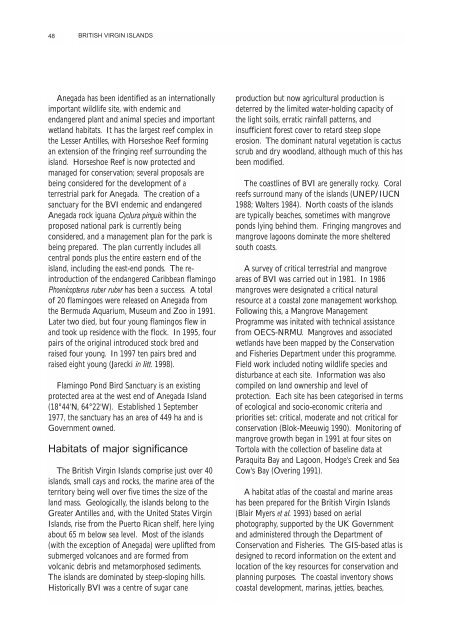Biodiversity: the UK Overseas Territories - WIDECAST
Biodiversity: the UK Overseas Territories - WIDECAST
Biodiversity: the UK Overseas Territories - WIDECAST
You also want an ePaper? Increase the reach of your titles
YUMPU automatically turns print PDFs into web optimized ePapers that Google loves.
48<br />
BRITISH VIRGIN ISLANDS<br />
Anegada has been identified as an internationally<br />
important wildlife site, with endemic and<br />
endangered plant and animal species and important<br />
wetland habitats. It has <strong>the</strong> largest reef complex in<br />
<strong>the</strong> Lesser Antilles, with Horseshoe Reef forming<br />
an extension of <strong>the</strong> fringing reef surrounding <strong>the</strong><br />
island. Horseshoe Reef is now protected and<br />
managed for conservation; several proposals are<br />
being considered for <strong>the</strong> development of a<br />
terrestrial park for Anegada. The creation of a<br />
sanctuary for <strong>the</strong> BVI endemic and endangered<br />
Anegada rock iguana Cyclura pinguis within <strong>the</strong><br />
proposed national park is currently being<br />
considered, and a management plan for <strong>the</strong> park is<br />
being prepared. The plan currently includes all<br />
central ponds plus <strong>the</strong> entire eastern end of <strong>the</strong><br />
island, including <strong>the</strong> east-end ponds. The reintroduction<br />
of <strong>the</strong> endangered Caribbean flamingo<br />
Phoenicopterus ruber ruber has been a success. A total<br />
of 20 flamingoes were released on Anegada from<br />
<strong>the</strong> Bermuda Aquarium, Museum and Zoo in 1991.<br />
Later two died, but four young flamingos flew in<br />
and took up residence with <strong>the</strong> flock. In 1995, four<br />
pairs of <strong>the</strong> original introduced stock bred and<br />
raised four young. In 1997 ten pairs bred and<br />
raised eight young (Jarecki in litt. 1998).<br />
Flamingo Pond Bird Sanctuary is an existing<br />
protected area at <strong>the</strong> west end of Anegada Island<br />
(18°44'N, 64°22'W). Established 1 September<br />
1977, <strong>the</strong> sanctuary has an area of 449 ha and is<br />
Government owned.<br />
Habitats of major significance<br />
The British Virgin Islands comprise just over 40<br />
islands, small cays and rocks, <strong>the</strong> marine area of <strong>the</strong><br />
territory being well over five times <strong>the</strong> size of <strong>the</strong><br />
land mass. Geologically, <strong>the</strong> islands belong to <strong>the</strong><br />
Greater Antilles and, with <strong>the</strong> United States Virgin<br />
Islands, rise from <strong>the</strong> Puerto Rican shelf, here lying<br />
about 65 m below sea level. Most of <strong>the</strong> islands<br />
(with <strong>the</strong> exception of Anegada) were uplifted from<br />
submerged volcanoes and are formed from<br />
volcanic debris and metamorphosed sediments.<br />
The islands are dominated by steep-sloping hills.<br />
Historically BVI was a centre of sugar cane<br />
production but now agricultural production is<br />
deterred by <strong>the</strong> limited water-holding capacity of<br />
<strong>the</strong> light soils, erratic rainfall patterns, and<br />
insufficient forest cover to retard steep slope<br />
erosion. The dominant natural vegetation is cactus<br />
scrub and dry woodland, although much of this has<br />
been modified.<br />
The coastlines of BVI are generally rocky. Coral<br />
reefs surround many of <strong>the</strong> islands (UNEP/IUCN<br />
1988; Walters 1984). North coasts of <strong>the</strong> islands<br />
are typically beaches, sometimes with mangrove<br />
ponds lying behind <strong>the</strong>m. Fringing mangroves and<br />
mangrove lagoons dominate <strong>the</strong> more sheltered<br />
south coasts.<br />
A survey of critical terrestrial and mangrove<br />
areas of BVI was carried out in 1981. In 1986<br />
mangroves were designated a critical natural<br />
resource at a coastal zone management workshop.<br />
Following this, a Mangrove Management<br />
Programme was initated with technical assistance<br />
from OECS-NRMU. Mangroves and associated<br />
wetlands have been mapped by <strong>the</strong> Conservation<br />
and Fisheries Department under this programme.<br />
Field work included noting wildlife species and<br />
disturbance at each site. Information was also<br />
compiled on land ownership and level of<br />
protection. Each site has been categorised in terms<br />
of ecological and socio-economic criteria and<br />
priorities set: critical, moderate and not critical for<br />
conservation (Blok-Meeuwig 1990). Monitoring of<br />
mangrove growth began in 1991 at four sites on<br />
Tortola with <strong>the</strong> collection of baseline data at<br />
Paraquita Bay and Lagoon, Hodge's Creek and Sea<br />
Cow's Bay (Overing 1991).<br />
A habitat atlas of <strong>the</strong> coastal and marine areas<br />
has been prepared for <strong>the</strong> British Virgin Islands<br />
(Blair Myers et al. 1993) based on aerial<br />
photography, supported by <strong>the</strong> <strong>UK</strong> Government<br />
and administered through <strong>the</strong> Department of<br />
Conservation and Fisheries. The GIS-based atlas is<br />
designed to record information on <strong>the</strong> extent and<br />
location of <strong>the</strong> key resources for conservation and<br />
planning purposes. The coastal inventory shows<br />
coastal development, marinas, jetties, beaches,
















